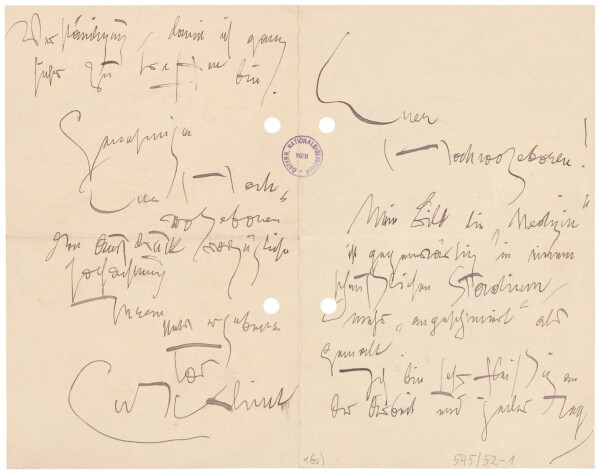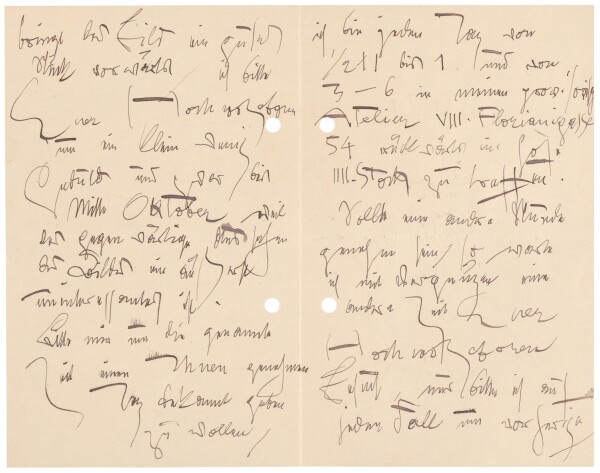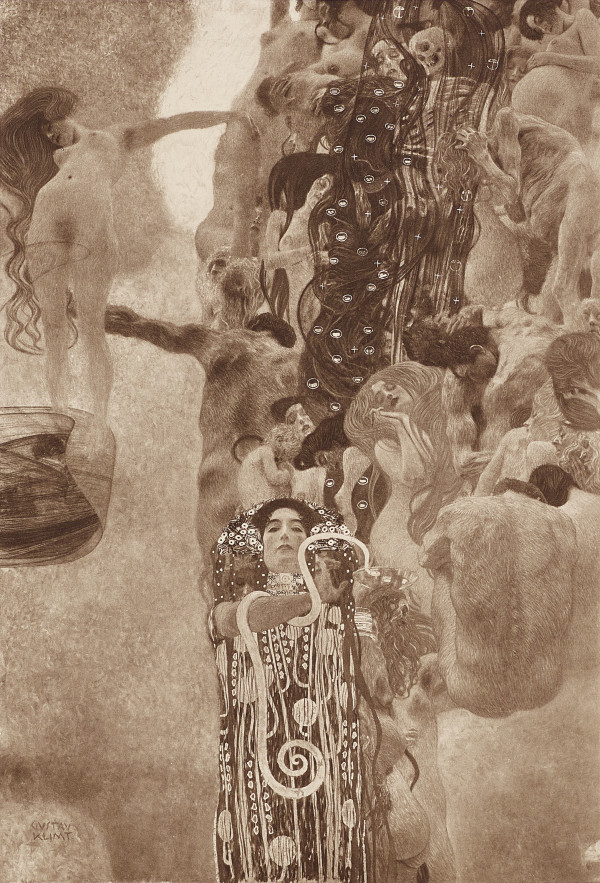Studio at Florianigasse 54

View down Florianigasse towards Landesgerichtsstraße, around 1904, Wien Museum
© Wien Museum

Advertisement for Ludwig Schmitt's furniture factory and cabinetmaker's workshop at Florianigasse 54, in: Wiener Salonblatt, 12.06.1892.
© ANNO | Austrian National Library
Gustav Klimt rented the attic-floor studio at Florianigasse 54 only for eight years. He used it alongside his main studio on Josefstädter Straße 21 to work on his large-format Faculty Paintings.
In 1898, Gustav Klimt had to rent an additional studio alongside his main studio on Josefstädter Straße 21, which he had moved into in 1890, to work on his commission for the ceiling paintings for Vienna University.
From 1894 to 1898, Klimt had worked on the commission for the Faculty Paintings in his studio on Josefstädter Straße, which he was still using together with Franz Matsch. When it came to executing the sketches he had created during this time, however, the rooms of the single-floor house in Vienna-Josefstadt, 8th District, proved too low to accommodate the monumental format of the Faculty Paintings, which measured 4.3 x 3 meters.
This prompted Klimt in 1898 to rent a temporary studio on the 4th floor of the joinery and furniture factory of Ludwig Schmitt at Florianigasse 54 (from 1906 number 50) in the 8th District of Vienna, in close proximity to his main studio. The painter affectionately called the attic-floor workspace his “altitude studio.” This term was likely a reference both to the studio’s situation on the top floor and to the height of the ceilings.

Gustav Klimt: Letter from Gustav Klimt in Vienna to Wilhelm von Hartel [?], presumably before October 1900, Austrian National Library
© Department of Manuscripts and Rare Books, Austrian National Library

Gustav Klimt: Letter from Gustav Klimt in Vienna to Wilhelm von Hartel [?], presumably before October 1900, Austrian National Library
© Department of Manuscripts and Rare Books, Austrian National Library
On account of his profession as an Imperial-Royal court carpenter, Schmitt moved in the same circles as Friedrich Paulick sen., who Klimt regularly visited at his Villa Paulick on the Attersee. Entries into the villa’s guestbook illustrate that Ludwig Schmitt, too, stayed there in 1894 and 1899. Thus, Klimt could have met the renowned cabinet maker Schmitt via the Paulicks before renting the studio in the furniture factory. From the turn of the century onwards, Schmitt increasingly produced Jugendstil furniture. For the World’s Fair in Paris (1900), for instance, he executed furnishings after designs by Joseph Maria Olbrich. It is believed that Klimt was close friends with the Schmitt family, and created designs for upholstery fabrics for his landlord.
Latest from 1900, Klimt spent most of his time working on the Faculty Paintings at his Florianigasse studio. In September 1900, he wrote to Maria Zimmermann:
“[...] as I am now working more out of the Florianigasse studio – tomorrow, I will finally start painting the large painting [NB: Medicine, 1900-1907], it is high time.”
In October 1900, he wrote to an unknown gentleman:
“I can be found every day from 10.30 am to 1 pm, and again from 3 pm to 6 pm, at my temporary studio in Vienna’s 8th District, Florianigasse 54, at the back in the courtyard, 4th floor.”
Gustav Klimt’s correspondence shows that he primarily worked out of his Florianigasse studio at least until 1907. Again and again, he asked acquaintances to meet him there or to write to him at this address.

Gustav Klimt: Medicine, 1900-1907, 1945 in Schloss Immendorf verbrannt, in: Kunstverlag Hugo Heller (Hg.): Das Werk von Gustav Klimt, Vienna - Leipzig 1918.
© Klimt Foundation, Vienna
Criticism and Stylistic Change at the Florianigasse Studio
Klimt worked for eight years on the three allegorical paintings: Medicine, Jurisprudence and Philosophy (1900–1907, destroyed in a fire at Immendorf Castle in 1945). Ludwig Hevesi reported that Klimt painted the enormous canvases using a ladder, which he kept climbing up and down. He further purported that Klimt was surrounded by thousands of scattered sketches and drawings.
The process of painting the Faculty Paintings, which Klimt carried out at his Florianigasse studio, proved difficult and time-consuming. He kept reworking the paintings, partly on account of his own dissatisfaction “[…] at present, Medicine is at a horrible stage, more smeared than painted [...],” partly owing to the harsh criticism from the university’s professors. When Klimt presented the still unfinished paintings to the public – Philosophy in 1900 and Medicine in 1901 – both works caused a veritable scandal. In 1905, the university decided not to use the ceiling paintings for the auditorium. This prompted Klimt to terminate his contract and to buy back his paintings. He continued to work on the paintings at the Florianigasse studio for a further two years. After their completion in 1907, Klimt left his temporary studio.
Klimt, who had rented the studio in 1898 as a renowned decorative painter with a public commission, left it in 1907 as a progressive, innovative painter of Modernism.
Literature and sources
- Peter Weinhäupl: Baustelle Fakultätsbilder. Klimts streitbare Moderne, die ungewollte Anerkennung und der Untergang, in: Sandra Tretter, Hans-Peter Wipplinger (Hg.): Gustav Klimt. Jahrhundertkünstler, Ausst.-Kat., Leopold Museum (Vienna), 22.06.2018–04.11.2018, Vienna 2018, S. 49-76.
- Brief von Gustav Klimt an Maria Zimmermann (September 1900). S63/15.
- Christian M. Nebehay (Hg.): Gustav Klimt. Dokumentation, Vienna 1969.
- Stephan Koja (Hg.): Gustav Klimt: Der Beethoven-Fries und die Kontroverse um die Freiheit der Kunst, Munich 2006.
- Mona Horncastle, Alfred Weidinger: Gustav Klimt. Die Biografie, Vienna 2018.
- Agnes Husslein-Arco, Alfred Weidinger (Hg.): Gustav Klimt 150 Jahre, Ausst.-Kat., Upper Belvedere (Vienna), 13.07.2012–27.01.2013, Vienna 2012.
- Ernst Ploil: Die Ateliers des Gustav Klimt, in: Tobias G. Natter, Franz Smola, Peter Weinhäupl (Hg.): Klimt persönlich. Bilder – Briefe – Einblicke, Ausst.-Kat., Leopold Museum (Vienna), 24.02.2012–27.08.2012, Vienna 2012, S. 98-107.
- N. N.: Von der Pariser Weltausstellung. Das Wiener Interieur, in: Neue Freie Presse, 29.07.1900.
- N. N.: LUDWIG SCHMITT. K. und K. HOFTISCHLER UND MÖBELFABRIKANT, in: Jubiläumsnummer der Wiener Zeitung. Beilage zur Wiener Zeitung, 08.08.1903, S. 144.
- Österreichisches Biographisches Lexikon. Ludwig Schmitt. www.biographien.ac.at/oebl/oebl_S/Schmid_Ludwig_1849_1906.xml (01/27/2022).
- N. N.: Jahresversammlung des Wiener Kunstgewerbevereines. (Original-Bericht des "Neuen Wiener Journal".), in: Neues Wiener Journal, 27.07.1899, S. 3-4, S. 4.
- N. N.: Localbericht. [Wiener Kunstgewerbeverein.], in: Das Vaterland. Zeitung für die österreichische Monarchie, 07.12.1898, S. 6.
- Hans Koppel: Bei Gustav Klimt, in: Die Zeit, 15.11.1903, S. 4-5.
- Adolph Lehmann's allgemeiner Wohnungs-Anzeiger. Nebst Handels- u. Gewerbe-Adressbuch für d. k. k. Reichshaupt- u. Residenzstadt Wien u. Umgebung, 47. Jg., Band 1 (1905), S. 1289.
- Adolph Lehmann's allgemeiner Wohnungs-Anzeiger. Nebst Handels- u. Gewerbe-Adressbuch für d. k. k. Reichshaupt- u. Residenzstadt Wien u. Umgebung, 48. Jg., Band 1 (1906), S. 1009.

